Meat garum (just think soy sauce made from meat) was the first thing I planned to make after flipping through copy of the Noma Guide to Fermentation, by Rene Redzepi, a book I know plenty of my friends have been experimenting with. It is some seriously mind bending, technical restaurant ideas and experiments, and not for the faint of heart, or the inexperienced.
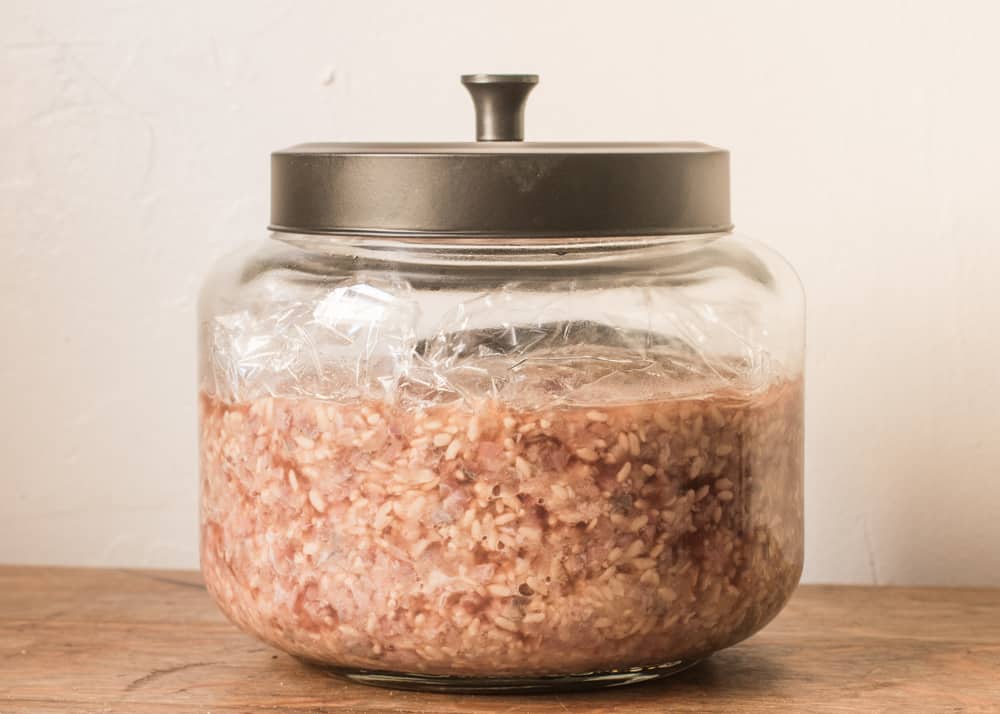
The good news is, just like any other book about cooking food, if you read carefully, you can find ways to attempt things that might seem unapproachable at first. With the Noma Guide to Fermentation, that might mean not making your own fermentation chamber out of a restaurant speedrack, covered with clear proofing plastic, with cords and all manner of robotics snaking out of it.
Or it might mean locating quality rice inoculated with koji spores to buy online, instead of trying to master innoculating your own at home, before you try any of the recipes. As you might guess, the above were two shortcuts I took making the meat garum.
If you're not familiar, garum is a fermented (kind of, technically the juices in the gut cause autolysis when they hit the meat) sauce made from small, whole, salted fish, or mixtures of fish and crustaceans, it was widely used and produced in the ancient world before the fall of Rome. I'd always wanted to make traditional garum, and I tried with Northern Pike last summer. That wasn't a huge success, but this garum I made with lamb definitely was.
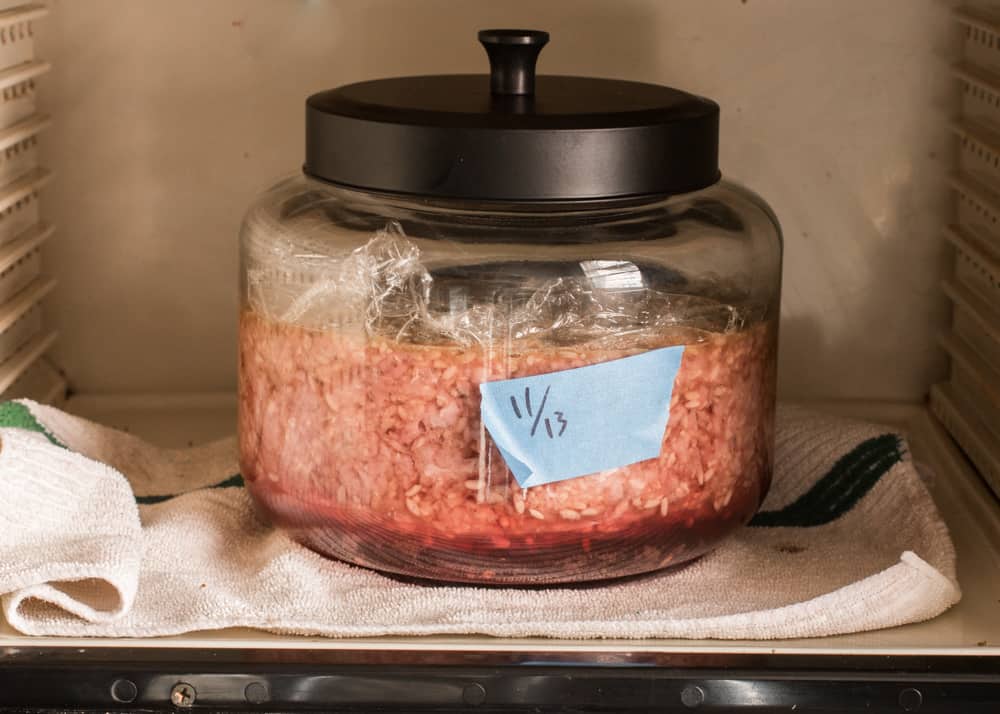
Meat Garum, the Jist
You take some ground meat (preferably a very lean cut as the fat needs to be skimmed) mix it well with salt, crumbled koji rice, and water, then put it in a non-reactive container (glass) and keep at a stable temperature for 30 days.
After 70 days, and skimming any visible fat here and there, the garum is done, and you strain it out, then strain it again, and again, until it's clear of impurities. The sauce will last a very long time, and, kind of tastes like soy sauce made from meat (which is a simplification, but a decent approximation).
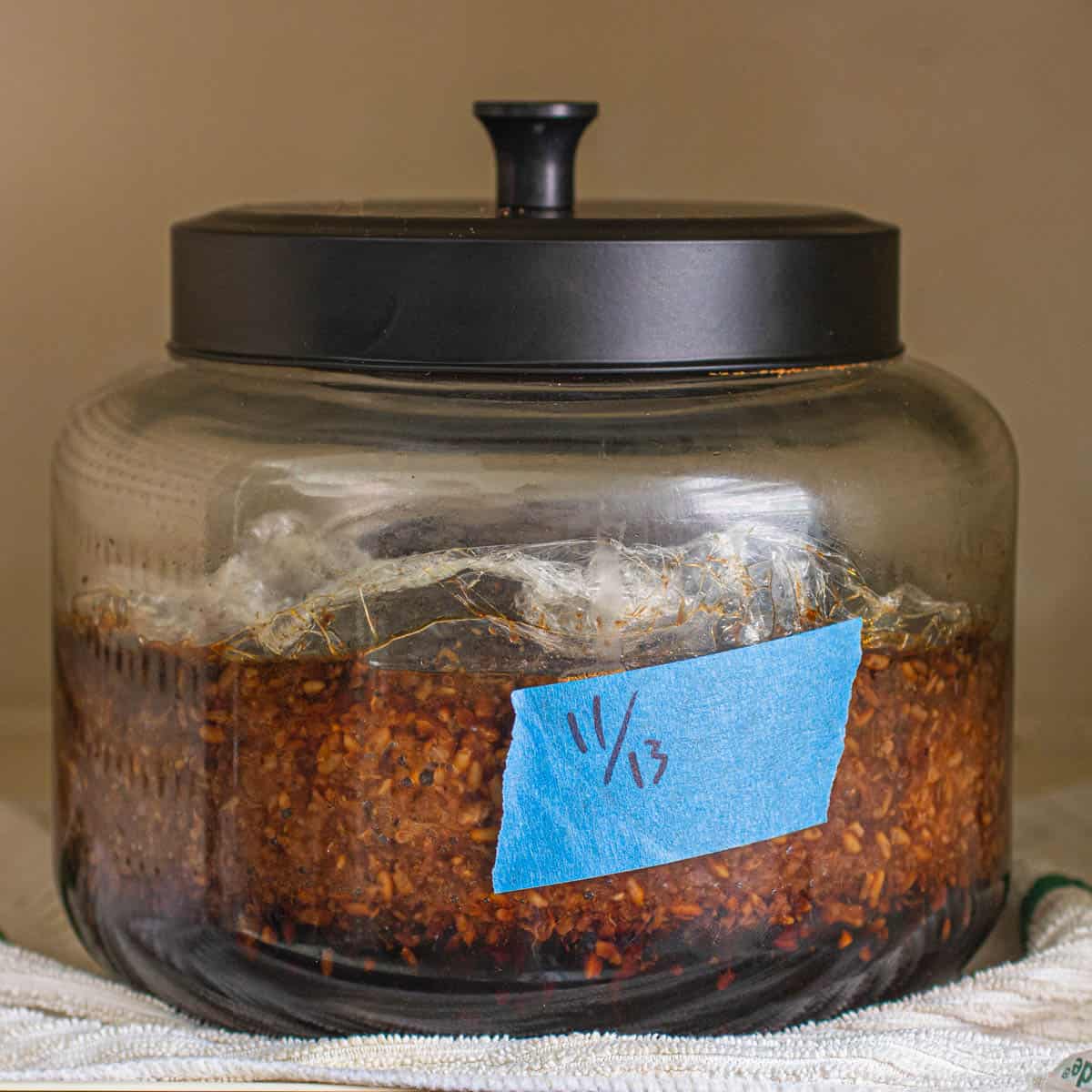
Using different meats
The Noma Guide illustrates their garum recipe using beef, but I was fresh out of it. With one of my current jobs being a consultant for a lamb and goat farm though, I had plenty of lamb, and perfect cut to experiment with: tongue.
Why tongue? Well, first, I had them. Secondly, I spend about half my time in between a farm and the city, where my apartment. I wouldn't have time to skim the fat from the garum as regularly as the recipe called for, so, tongue, being just about the leanest cut I knew, seemed like a great, low-maintenance choice.
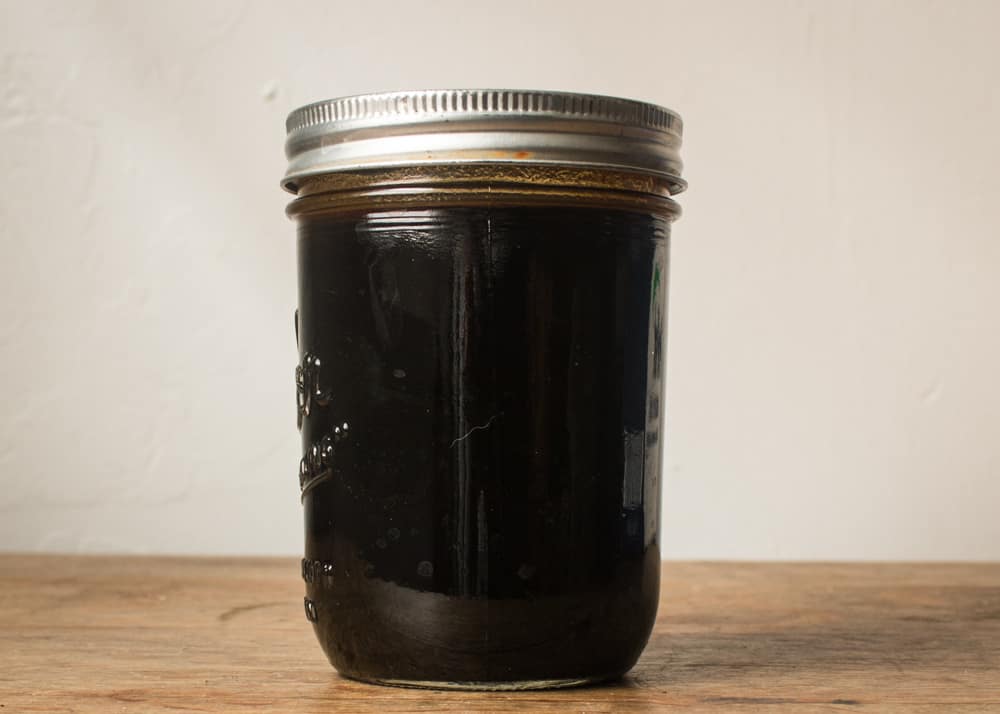
Improvising a fermentation chamber at home
This was the only thing that gave me pause in the original recipe: the meat slurry has to be kept at a stead temperature of 140 degrees, for 70 days. The book explains instructions for how to craft a fermentation chamber with a controlled temperature, but no one that without access to a good amount of kitchen equipment and know-how will attempt it, trust me.
Good thing is that my old Harvest Maid dehydrator goes up to 140, and I knew if I took all the shelves out I could fit some kind of fat, glass vessel in it, which are easily scored at a thrift store. Also, thrifting is what plenty of hunters I know do when craving a fix do in the off season.
Koji rice
This is rice that has been inoculated with a fungus used to make miso, in the Noma Book, they make their own out of barley, of course. I did a fair amount of research on this, first locally at a handful of Asian markets, then finally online.
One of the online products in particular seemed to get rave reviews for similar things I wanted to do with it, so I grabbed a few. Obviously I'm a koji newb, and the masters all ferment their own stuff, but starting out I didn't want to dedicate too much mental space to the experiment. Here's a link to the brand I've been using.
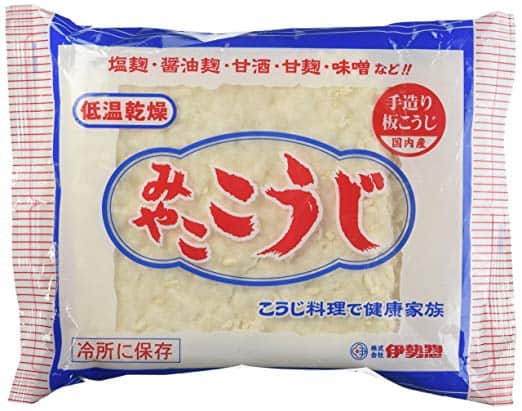
Finished product
Like I said in the at the beginning, this is cutting edge stuff. The flavor profile is like soy sauce, but the meat flavor is definitely there, and with mine, the lamb was there too, in a really pleasant way.
It's toasty, nutty, dark and rich. It's also salty, aggressively so, but it's supposed to be, and I've actually been surprised by how little I need to add to season something solely with the salt content of the garum. 5lbs of sausage would take more than ½ cup! Even then, as with anchovies, I still like to adjust the flavor with a pinch of salt here and there.
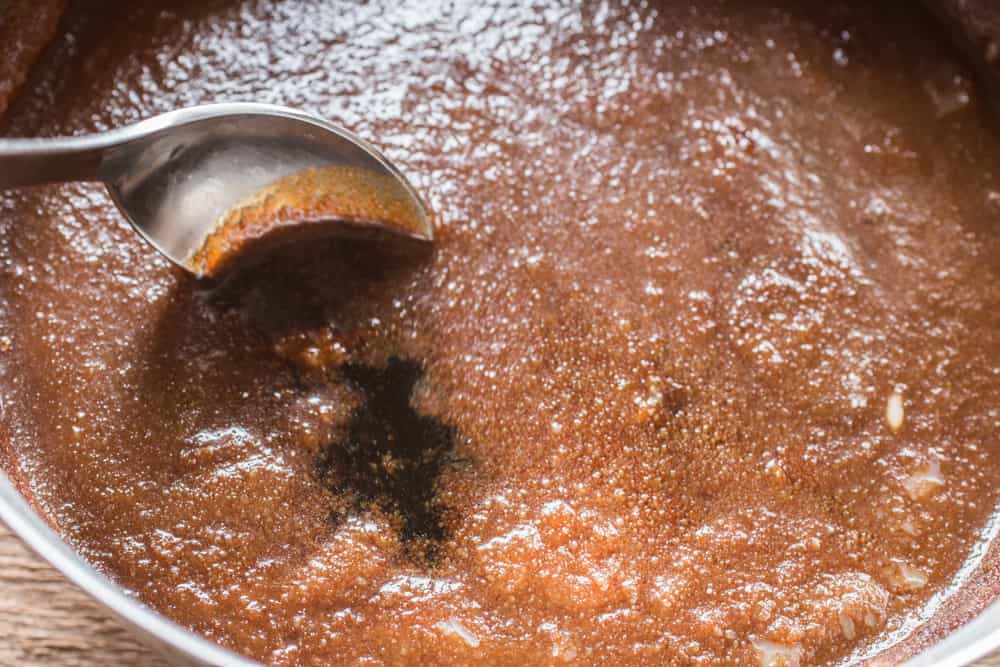
How do you use it?
Remember, this is a background seasoning, not necessarily something you need to taste overtly in a dish, just think soy sauce made from meat. A little goes a long way, (kind of) but, just like cooking with anchovies, Worcestershire, or fish sauce, it's ok to add a little salt after you add the concentrated liquid to adjust it.
With my garum, since I used lamb, the first things I thought to use it with included more lamb, the sort of way you'd start a lamb braise with lamb stock. Here's the first ideas I jotted down in my journal:
- Good rice cooked in lamb stock, garnished with butter and lamb garum instead of soy sauce
- Soup with lamb broth, lamb garum. Wilted greens. Some kind of herb? Noodles?
- A garum based marinade for pieces of lamb that would be roasted or grilled
- A marinade for jerky
- Seasoning bratwurst and sausages that need to marinate in the fridge for a day or two before casing
Meat Garum
Equipment
- Dehydrator or temperature controlled fermentation chamber
Ingredients
- 1000 grams 2.2lbs lean meat (I used lamb tongues but that isn't economical for most people)
- 240 grams Kosher salt
- 800 grams Water
- 200 grams Koji rice 1 package, see supplier in notes
Instructions
- Sterilize and sanitize fermentation vessel, or put it through the dishwasher if possible. Cut the meat into pieces that will fit in a meat grinder.
- Mix the cut meat with the koji rice, then put through the meat grinder. Mix the salt into the ground meat-rice mix, then carefully mix in the water. You can also buzz the whole mixture with a hand blender before putting in the fermentation vessel.
- Carefully ladle the meat slurry into the fermentation vessel, press down firmly with plastic, put on the lid, then put it in the dehydrator and set the temperature to 140 degrees. Check frequently on the garum during the first week and skim any fat that rises to the surface, and refresh plastic if needed. Skim the fat weekly after the first week. After a couple weeks, I didn't have to skim mine.
- After a couple days, you'll see a raft forming, and gentle bubbles in the mix letting you know the magic is happening. Remove the garum after 30 days, carefully strain out the liquid, then chill the liquid until any fat has congealed on top and can be easily spooned off.
- Strain the mixture again for good measure. Finally, tare a scale with a mason jar on it weighing in grams, pour in the garum, adjust the weight back to 800 grams with fresh water (or leave it as-is if you prefer it stronger), screw on the lid, label, date, and refrigerate until needed.
Notes
Recipes
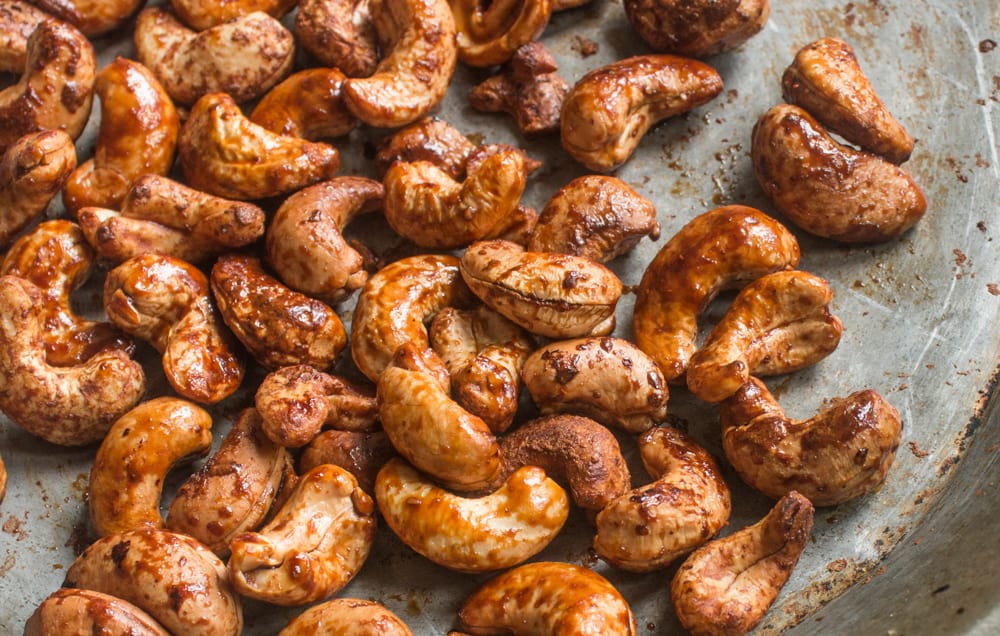
Toasted Cashews with Lamb Garum
Ingredients
- 1.5 cups whole cashews
- 2 tablespoons meat garum
Instructions
- Preheat an oven to 325. Put the nuts in a 10 inch saute pan, preferably a cast iron skillet or a non-stick pan with concave sides for easy tossing. Being able to toss and coat the nuts quickly is essential to completely covering them with the coating. Toast the nuts for 15 minutes, or until nicely browned. Turn the oven off.
- Then, working quickly, and having the meat garum at the ready, put the pan with the nuts on a burner on high heat. Add the garum, it should sizzle and sputter.
- Cook the nuts for a few seconds to quickly evaporate the liquid, tossing the nuts to coat them. When the liquid is evaporated, turn the heat off, transfer the nuts to a small plate or baking dish and allow them to dry in the oven ajar, with the heat turned off.
- When the nuts are cool, they'll be coated in a crisp, salty covering. They were so good I ate all of them in a sitting. Mushroom ketchup would be an excellent substitute here for the meat garum, too.
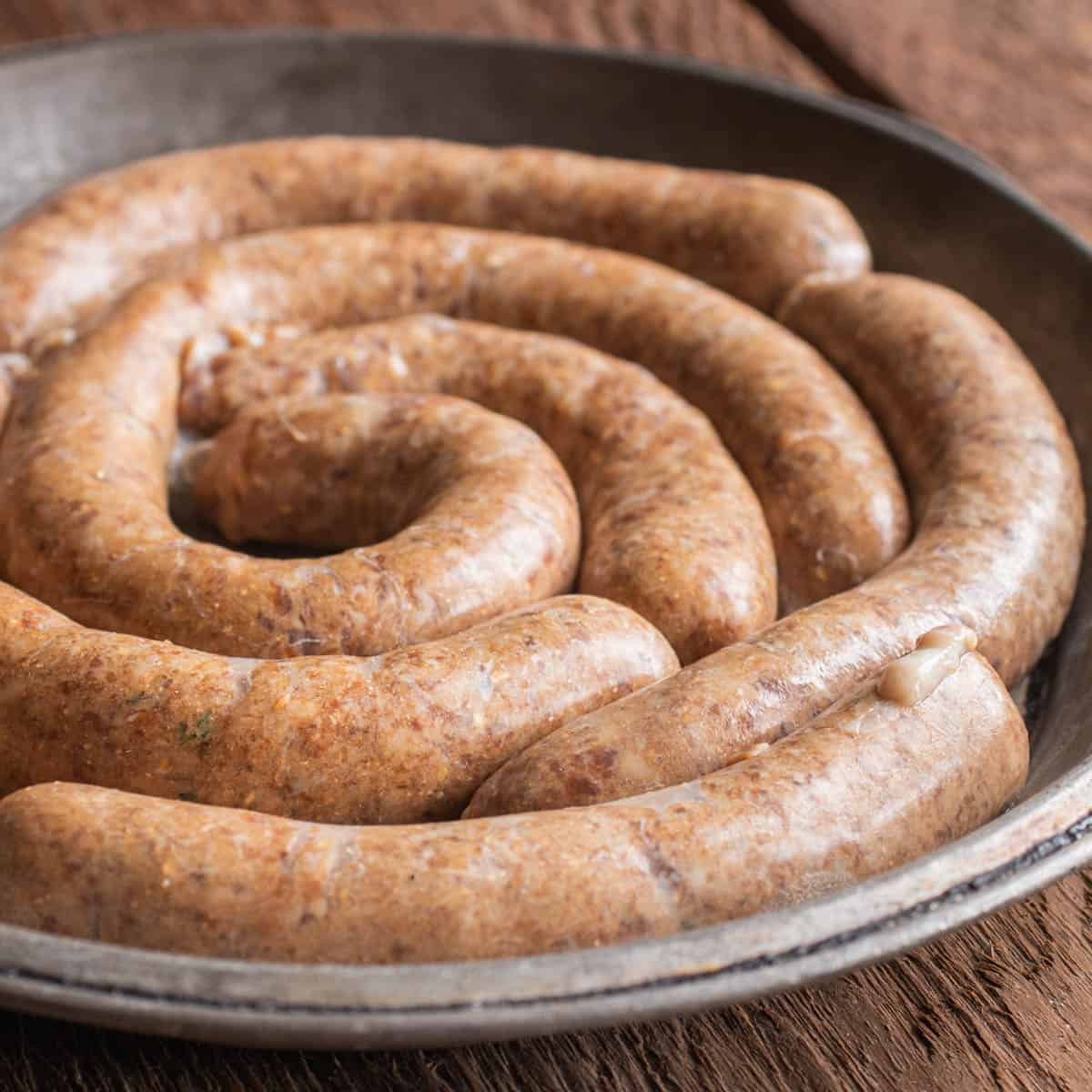
Puffball Mushroom Lamb Brats
This was what my sausages seasoned with the garum turned into. I was worried about the relatively high amount of liquid monkeying with my sausage, so as binder, instead of milk powder, I used toasted puffball powder. They're fantastic.

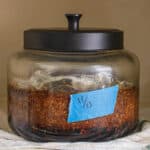

Phillip
what kind/brand of dehydrator did you use that ran for this long?
Alan Bergo
Harvest Maid. You can still find them on Ebay here and there.
Ashkan
I’ve long wondered about doing something like this, but with natto spores and keeping it around 95f instead. I reckon it’d be something like a controlled version of high meat. What do you reckon?
Alan Bergo
I haven't worked with natto spores personally.
Erin
Hi!! Can you substitute shrimp for the lamb and vitamix/blend the shrimp with the Koji, salt and water?
Follow the rest of the recipe as is?
Thanks!!
Alan Bergo
Yes.
Aaron
When its done and you have strained it, do you add water back in to get to the original liquid weight of 800g, or just leave it as is?
Alan Bergo
Yes you can, and it's a good idea. I adjusted it to reflect that, thanks.
Patrice Lapointe
My 2nd bath of garhum is now ready to filter. What do you use to filter your garhum and remove all the fine particle floating around? I tried usong a coffee filter but it clogs almost immediately
Patrice Lapointe
Hello. Thanks for this article. I read the book too and so far I did some squid garum with some kind of success. I say "some kind of success" because it's not as good as the Red Boat fish sauce I buy at the store but it's definitely garum so I call it a success. Anyway, now I want to try beef garum and I'm looking for some clarification. Perhaps you can help? First, do you rehydrate your koji rice or do you dump it in there dried? Second, could I follow the recipe but do it at room temperature instead of higher temperature? I assume it would take longer but is this the only down side?
Thank you
Alan Bergo
Patrice, you add the koji rice directly to the mixture, the natural water will hydrate it. You can probably do it at room temperature, but it will take longer and will not have the same color (I'm assuming) unless it's exposed to a lengthy amount of ambient heat, like full sun in the summer. Let me know if it works for you. I also agree there's no substitute for Red Boat fish sauce!
Patrice Lapointe
Thanks for your reply. I’ll start a batch today. Do you know if it has to be used dried in miso too? I tried a batch of miso the other month. I rehydrated the koji before use. The result is disgusting. Something very wrong happened to my miso. There are many possible causes but perhaps the rehydrated koji is one of them. Anyway thanks. I’ll start a batch and will let you know how it goes.
Aleksandar Zvorinji
Could you do this without the koji if you had the patience? What about temperature? Could you leave this in like a yogurt machine at a lower temperature for a longer time? Could you do this with dry aged beef? Cooked to create a crust and then ground? Why does it need to be refrigerated unlike fish sauce? Or is refrigeration more of a benefit to ensure freshness than a safety requirement? Thank you for your insight! This was a fascinating read.
Alan Bergo
You could probably do it without koji. If you don't refrigerate it, you might get kahm yeast.
Eldwin
Ive looked up 2 other recipes and they both call for fermenting at 104F/100-110F, did the recipe offer an explanation into why the particular 140F?
Source1: https://coquinaria.nl/en/roman-fish-sauce/
Source2: http://www.grouprecipes.com/112785/authentic-roman-garum-fish-sauce.html
Alan Bergo
Cooking it at those temps will slowly caramelize proteins and develop flavor. 140F or so, with the koji, is a combo of speed and caramelization. The recipe linked here made in a yogurt maker will make poor quality, simply salty garum, 3-4 days of "fermentation" is not going to develop into anything interesting IME.
Eldwin
ah, bc higher temps accelerate the fermentation process & sugar breakdown. good to know
Jonathan
I'm not knocking the recipe or procedure, just trying to get some clarification around terminology:
Fermentation, specifically koji-based, happens 104F (40C), koji dies.
Perhaps the process here is less about koji-based fermentation, and more about the chemical reactions going on at 140F?
Really, my question (and I'll break out the Noma book next) is: why use koji at all if it's dying >40C and we're "cooking" at 60C?
Jonathan
*<104F
Alan Bergo
That's a great question to ask Renee Redzepi. I'm not an expert on koji by any stretch of the word--I haven't grown my own yet. That's why I don't take credit for the method at all, I'm just sharing the process from the book in a way that worked for me in a home kitchen more approachable to people who don't have the space or means to use some of the more restaurant-intensive apparatus and methods described in that book. I suspect you're right here. Maybe the koji helps contribute some of the caramelized flavors you get in the finished product? But then again, you're going to get plenty of that from the slow Maillard reaction from the sugars in the protein itself. Try out a batch without the koji and keep me posted. A
Jonathan
You know what, on further reflection, I'm thinking it's inaccurate to call this garum process "fermentation." I think that the koji is indeed necessary, but for its enzymes rather than for its spores. The koji rice used is full of various enzymes that break down the proteins, and these are probably active to 140F. So, basically, I was getting hung up on the minutiae.
I still haven't read the garum chapter in the book, I'll post back if I learn something different there...
Alan Bergo
Sounds logical to me as the enzymatic autophagy is what typical garum relies on, and that definitely happens at higher temps, just in an extended format in the sun which I'd assume can reach similar temps in the places it was made for the traditional versions. It's for sure not fermented, even a bit--I don't taste anything lactic in the finished product. By comparison, the dryad saddle shoyu I riffed on from the book most definitely is heavy on the lacto-flavor, and one version I did got super bitter from forgetting about it for just a few extra weeks without killing the ferment. If the koji is acting as an enzymatic accelerant in the same way it can with lacto-fermentation it would really give me another reason to love the stuff. Thanks for adding a good nugget in this comment thread.
Jonathan
Oops, some problems with my post: ...Fermentation, specifically koji-based, happens ****104F (40C), koji dies...
Eldwin Cheung
What’s the reasoning for skimming the fat?
Alan Bergo
Because fat can develop musty odors.
Vishal dandekar
Can it be kept in an warm oven as I have either off them
Alan Bergo
Possibly. I haven't tried it. Keeping an oven turned on for 30 days would be prohibitively expensive.
Eldwin
Ancient garum was simply fish offal mixed with salt and left in a barrel in the sun for several months. I assume the barrel could reach 140F, why not just do that instead of all the additional work of getting Koji rice and and a temperature controlled environment?
Alan Bergo
Did you read the post? Have you made ancient Garum? For one, speed. This will be done in about a month as Koji hyper-speeds the fermentation, compared to at least 6 for traditional. Also, ease. Traditional grail needs ambient heat like the beating sun to work its magic. Koji and a food dehydrator let me make this in my apartment Test kitchen, unattended for weeks at a time, in Minnesota, in the Winter. It’s also more fool proof. With the heat and Koji, the most you’ll have to worry about is possibly keeping an eye out for mold. With traditional garum, all kinds of things can go wrong, an army of maggots, for example.
Eldwin
"Did you read the post? Have you made ancient Garum? For one, speed. This will be done in about a month as Koji hyper-speeds the fermentation, compared to at least 6 for traditional."
- no i have not made it, and yes i did read the post. these questions clarify things not explicitly mentioned, such as where was it mentioned in the post that koji would hyperspeed the process? adding koji helps foolproof it? i didnt see it in the article.
"Also, ease. Traditional grail needs ambient heat like the beating sun to work its magic. Koji and a food dehydrator let me make this in my apartment Test kitchen, unattended for weeks at a time, in Minnesota, in the Winter."
- definitely sounds a good plan given the environment
"With the heat and Koji, the most you’ll have to worry about is possibly keeping an eye out for mold. With traditional garum, all kinds of things can go wrong, an army of maggots, for example."
- for maggots...dont there need to be fly eggs in the first place to have em. if there werent flies getting to the lamb tongue beforehand, there wont be any chance of maggots, right?
in traditional kimchi-making, all molds that form on surface are simply scooped off at harvest time. is there any reason why fat need be continually skimmed.
now dont get my intent wrong, all these questions arent meant to be finger-pointing. im really just curious about the whys.
Luc
The meat does not Contain the same bacteria and enzymes that a fish's digestive tract does this is why you introduce koji - it contains cultures that break down the protein. Also unless you are in the med you are unlikely to maintain sla solid and consistent tempratures so a hot cupboard is the safest way
Chris
Alan, does the meat need to be cooked first? in Noma's chicken garum they roast it first
Alan Bergo
No. In Nomas beef garum they do not---two different garums here if you're looking at the book. The chicken wing garum is online and available for reference, but the raw beef garum is not. You could prob make a hybrid combining both of them.
Arthur
Should I be worried that my beef garum (currently at day7) does not have liquid down the vessel? I’ve skimmed the fat daily and stir the garum a bit every time before changing the plastic film and now it just seems like any liquid just accumulates at the top.
Alan Bergo
Are you "cooking it" at the recommended temperature? Did you weigh your salt?
Luke
140 is it Fahrenheit or Celsius?
Alan Bergo
F
Daniel
It stays in the dehydrator all 70 days, or am I missing a step?
Alan Bergo
Yes, 70 days in the dehydrator. Straight from the Noma book.